Michael Deigan was a harp maker, player and teacher in the south-west of Ireland in the 1840s. We have a huge problem because at the moment we don’t know if he was a classical harpist, or if he had learned to play the traditional wire-strung Irish harp in the inherited tradition. This post is to try and say something useful about him.
We have very few records of Michael Deigan. We have advertisements for a couple of concerts he performed in, we have an advertisement for harps he has for sale, and we have a harp that he made. However we don’t know where he was from, or when he was born, or where and from who he learned the harp. It is not 100% certain that these are all the same person. But we will see what we can find out anyway.
Harp making, 1842
I first came across Deigan’s name on a harp that he made, which I saw in the National Museum of Ireland storage facility back in 2019. I had another look at this harp in March 2023 when I was in studying the 19th century traditional wire-strung harps, but I did not spend much time looking at it and I have not done measurements and I did not do even a cursory photo-survey of it; I just took a few quick snaps.
The harp has the maker’s inscription painted twice on the soundboard, once on each side:
M:- DEIGAN .\\\
National Museum of Ireland, NMI DF:1968.1
MAKER .\\\
Silver Mines
~ No.- 44 .\\\
A:D: 1842 \\\
Silvermines is presumably where Deigan was based; it is a mining village so presumably there would be plenty of skilled wood and metal workers and workshop facilities there connected to the mines.
I am interested that the harp is numbered, “No. 44”, as if Deigan had already finished 43 other harps before he made this one. I suppose that it is possible he did not start his numbering sequence at no.1; he may have numbered the first he made no.40, or even no.42 if he started making harps in 1842. I don’t think we can tell.
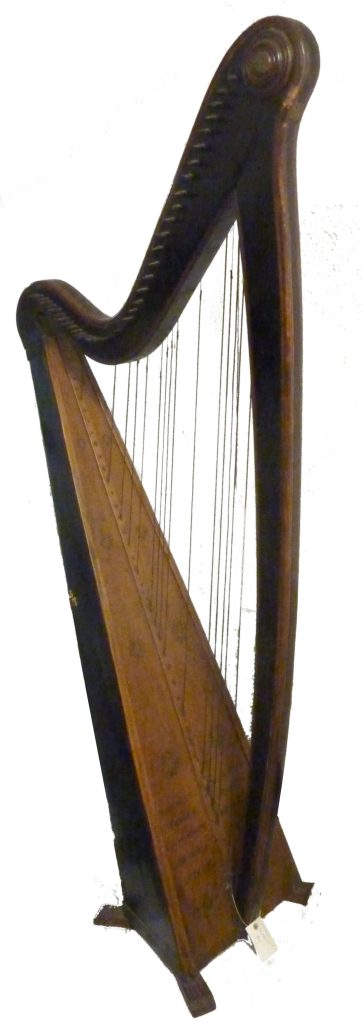
The harp seems competently made and well finished. It is clearly inspired by the design of John Egan’s traditional wire-strung Irish harps, even down to the style of writing the maker’s name, place, date and number on the soundboard, which was a thing Egan as well as Hewson did consistently with their traditional wire-strung Irish harps, though not as far as I know on their classical gut-strung harps.
Deigan’s harp is taller than the other traditional wire-strung Irish harps I have seen. I have not measured it, but I estimate it is about 1.8m high. It seems to have 39 strings, which is one or two more than the traditional wire-strung Irish harps made by John Egan in the 1820s and Francis Hewson in the 1840s.
The harp is currently fitted with gut strings. The long bass strings are high-twist plain gut; many of them have broken and they have been attached at the top ends by thin wire or string in a cosmetic restoration. Of course it is quite possible that some later owner may have fitted these gut strings; I know of a few other traditional wire-strung harps that were later re-strung in gut for classical players, including Patrick Byrne’s Egan harp, and the harp by Goudy in the NMI said to have been played by Valentine Rennie. So, we cannot use these strings to prove whether the harp was originally designed and set up as a classical harp or as a traditional wire-strung harp.
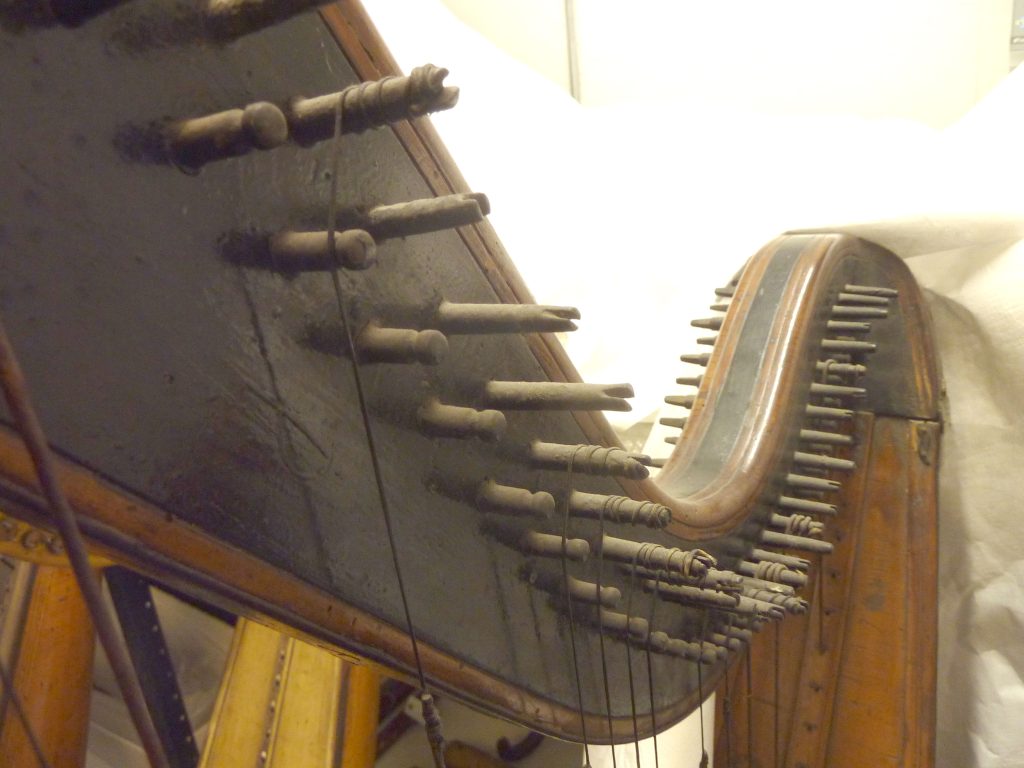
The harp does not have any kind of semitone mechanism. In the 19th century even more so than today, the use of semitone mechanisms was pretty much universal on any harps designed for use by classical harpists playing on gut strings. So to see Deigan designing and making a harp with no chromatic capability and no semitone mechanisms suggests strongly to me that he may have been thinking in terms of traditional wire-strung harp design.
The tuning pins have split ends, rather than the usual drilled ends for the wire strings to attach to. Split ends are a more common feature on gut-strung harps, especially on the traditional Welsh harps that were known and played in Ireland through the 18th and much of the 19th century. So to see these split-ended tuning pins makes me wonder if Deigan designed this harp with gut strings. I suppose the pins could have been modified when the gut strings were added, especially if they were originally drilled with small holes for the wire strings; the replacement gut strings would have been too thick to fit into the small holes and so filing the slots would be a quick way to adapt the pins for gut strings.
Research questions
My next research questions about this harp would be to try and answer the problem of whether it was designed as a traditional wire-strung Irish harp, or whether it was designed as a classical gut-strung harp. I would like to inspect inside the soundbox, to see if there are any fragments of wire strings inside (like I found inside the Rennie harp).
I would also like to find out if there is documentation in the NMI archive relating to the acquisition of this harp. The harp entered the Museum in 1968 and so I would hope there might be some kind of documents, whether a sales receipt, or correspondence with a previous owner. These documents may or may not exist, and if they do exist they may or may not give us hints as to the earlier history of this harp.
I would also like to measure the string lengths, because an analysis of the string spacing could give us indications as to whether it would work with wire strings or with gut strings. A brass wire string is shorter than a gut string at the same pitch; so the taller shape of this harp may be because it has the longer string lengths required for gut strings. But I would want to calculate this based on accurate measurements rather than just guess.
Harps for sale, 1842
The same year as he made the harp we have been looking at, Michael Deigan placed an advertisement in the Limerick newspaper:
THE IRISH HARP
Limerick Reporter, Fri 6 May 1842, p3
____
NOW FOR SALE
TWO Beautiful HARPS, in the possession of Mr. Michael Deigan, at Mr. HYNES’S Hotel, No.2, Bedford-Row, Limerick.
Mr. DEIGAN respectfully begs to call public attention to the above instruments, but more particularly Temperance Societies, who will now have an opportunity of reviving this too-long neglected record of Irish Minstrelsy, as they can be had on moderate terms. It would be worthy the great cause of Temperance to patronise this national emblem of the glory of other days.
N.B. Mr. D. gives instructions on the Harp, and will attend to any commands he may be favoured with.
No. 2, Bedford-Row, Limerick.
May 6, 1842
Now the first thing we should notice is that he does not say that he has made these two harps, only that he possesses them and is offering them for sale. I don’t know if he is being coy, thinking that it makes him look more superior to be seen as a dealer rather than as a woodworker. Social status and hierarchy was much more important in the 19th century than it is today and people took these subtle class signifiers much more seriously.
The second thing we should notice is that he is also offering to give harp lessons. Obviously this is a good marketing ploy, to encourage people to make a purchase. But it makes us wonder, what is he teaching? Where did he learn from? Again, the crunch question is whether he learned in the inherited tradition of playing on the wire-strung Irish harp, learning from a tradition-bearer who had come most likely through the Belfast harp school under Valentine Rennie or his colleagues; or whether Deigan had learned classical pedal harp under one of the classical harp teachers who was active in Ireland, such as Bochsa. There is also the possibility that he was a self-taught autodidact, but I think this was much less common in the 19th century, since both the classical harp tradition (on mechanised gut-strung harps) and the inherited Irish harp tradition (on the big wire-strung Irish harps) were both thriving in Ireland in the 1840s.
It may be slightly significant that he does not mention having come from the Irish Harp Society in Belfast, or having any certificate or testimonial from the Society or from other aristocratic patrons. The traditional Irish harpers often mention this, as a proof of their working within the inherited tradition.
Concert performances, 1843
I have records of two different concert performances, both in the south-west in 1843. The first was in Tralee. The context is a Temperance ball and concert featuring a wind band, a string band, and our harper:
⁎*⁎ It will be seen by our Advertising columns that Mr. Diegan, the celebrated Irish harper, will exhibit his powers at the approaching Concert to be held in the Castle-street Temperance Rooms.
Tralee Chronicle Sat 1 Jul 1843 p2
CONCERT AND BALL
Tralee Chronicle Sat 1 Jul 1843 p3
____
THE Members of the CASTLE-STREET TEMPERANCE HALL take the liberty of informing the Inhabitants of this Town, that a CONCERT and BALL will be held at their Rooms on MONDAY EVENING, the 3d JULY inst., at which the celebrated Irish Harper Mr. DIEGAN, will perform alternately with their Brass and Violin Bands. July 1
The Temperance Hall was on Upper Castle Street in Tralee, but I am not finding its exact location on the street. This is a very interesting event; a Concert and Ball, with the Temperance society’s wind Band and their string band presumably playing selections in turn, and with Deigan playing the harp inbetween. We saw Deigan mentioning temperance in his harp sales advert the previous year. We will discuss the temperance context later.
We find Deigan back in Limerick five months later, taking part in a Killarney-themed concert, alongside a well-known traditional piper:
Killarney Lakes.
Limerick Chronicle Wed 29 Nov 1843 p3
UNDER THE IMMEDIATE PATRONAGE OF THE COUNTESS OF DUNRAVEN,
GANDSEY,
THE CELEBRATED KILLARNEY MINSTREL
ASSISTED BY HIS SONS, THE KILLARNEY BUGLERS,
WILL have the honor of giving a MUSICAL ENTERTAINMENT, on SATURDAY Next, December 2d, 1843, at SWINBURNE’S GREAT ROOM, Brunswick-street, at Two o’Clock in the afternoon.
In the course of the performance, Mr. GANDSEY will play on the IRISH PIPES, some of the finest Irish, English and Scotch Airs, with variations, assisted by Mr. DIEGAN, the celebrated IRISH HARPER.
Admission, 2s. 6d.; Family Tickets 7s. 6d.
☞ By permission of the Right Worshipful the Mayor, an Evening Concert will take place under distinguished patronage, on TUESDAY Evening next, the 5th December
November 29
Now this is a very different event to the temperance ball earlier that year. Gandsey (1769-1857) was a famous and much admired Irish piper from County Kerry. We have a nice portrait of him, and he is remembered in the piping tradition as a very good piper. He toured to Dublin and Edinburgh as well as mostly playing in County Kerry. His sons more often accompanied him on the fiddle, though I have seen other references to them playing bugles.
The advert mentions Gandsey’s patron, the Countess of Dunraven, and so we can see that this is a much more high powered high society event, in a prestigious hotel venue in Limerick. Deigan here clearly has a supporting role to the famous Gandsey and his bugling sons. I haven’t found any other references to Gandsey performing alongside a harper, so perhaps this was a one-off. But I have not done an exhaustive study of Gandsey and his celebrity career.
Later references
The only later references I have found so far to Deigan’s name are brief auction listings for a secondhand harp which was being sold in Limerick in 1849. The harp is listed in an auction sale for Wed 24 January 1849, and then again in June and July 1849. I don’t know if this is the same harp which went unsold in January, or was flipped by its buyer, or if this is two different harps.
UNRESERVED AUCTION
Limerick and Clare Examiner, Sat 20 Jan 1849 p3
PATRICK COLEMAN
HAS been Commissioned to Sell by Strictly Unreserved Auction at his MART, 5, CHARLOTTE’S QUAY, on
WEDNESDAY NEXT, 24TH INSTANT,
Two beautiful Sofas, one Sofa Bed, a superb Pair of Spring bottom Loungers…
…a very excellent harp, (by Deegan,) and box of Strings…
…
So this one is described as a “harp by Deegan” and it comes with a “box of strings”. Mike Baldwin has written about how gut harp strings were stored in tin boxes, and so perhaps this points to the harp being a classical harp? I suppose it is even possible that the name is a spelling mistake for a pedal harp maker: could it possibly be an error for “Egan”?
Coleman advertises another harp for his sale on Wed 27 June 1849:
PATRICK COLEMAN
Limerick Reporter Fri 22 Jun 1849 p3, reprinted Tue 26 Jun 1849 p3
WILL Sell at his Mart, 5, CHARLOTTE’S QUAY, on WEDNESDAY next, 27 Inst., a collection of splendid Furniture, consisting of Sett of Telescope Tables, Sett of Northumberland do., Round and Sofa Tables…
…Dressing Cases and Writing Desks, Piano Forte, by Clementi; an Irish Harp by Deigan; Eight Day Clock…
Now this time the harp is explicitly described as an Irish harp; though that does not necessarily tell us anything because in the 19th century, pedal harps by Irish makers were often described as “Irish harps”.
Obviously some of the items did not sell on Wed 27th June, because we see some (but not all) of the items advertised the next month for a sale on Friday 20th July:
PATRICK COLEMAN
Limerick and Clare Examiner Wed 18 Jul 1849 p3
WILL SELL
AT HIS MART, No. 5, CHARLOTTE’S QUAY,
On FRIDAY Next, the 20th Instant,
A COLLECTION of Splendid FURNITURE, consisting of set of Northumberland tables, round and sofa tables…
…dressing cases and writing desks; piano-forte, by Clementi; an Irish harp, by Diegan; eight-day clock…
There’s not much more we can say about all this I don’t think. It is probably far too much to wonder if this is the harp that is now in the NMI.
His name
Michael Deigan is the name given in the advertisement that he placed with harps for sale. The harp that he made is signed M. Deigan, and so his own spelling of his surname seems clear enough. The other adverts for his performances gives his name as Diegan, with the i and e swapped. Later adverts for a harp by him being sold at auction give his name as Deigan or Deegan.
This is of course assuming that all these different references, all from the 1840s, are referring to the same person.
Gaois.ie says that Deegan is the anglicised verions of Duígeann, formerly spelled Duibhginn. Barry Griffith’s maps show Deegan as being concentrated across the central south midlands. His maps show Diegan as being incredibly rare; Deigan is hardly more common but you can see all three names are in that same general region. It is not clear to me if Duggan / Doogan, and Duignan are related names or not.
His places
We can make a map to see how the different places that Deigan was active in, relate to each other. You can also zoom out to see the other places mentioned below in relation to Father Burke. Touch a dot to see its name; click a dot for more info.
Temperance and the Harp
I am very interested to see temperance appearing twice in relation to Deigan. In his advert of 6 May 1842, offering harps for sale in Limerick, he addresses his advert to the general public, but then he addresses “more particularly Temperance Societies”; he explains that Temperance Societies who purchase his harps “will now have an opportunity of reviving” the Irish harp; and he concludes with an exhortation to them: “It would be worthy the great cause of Temperance to patronise this national emblem…”
The following year, on Mon 3 July 1843, we see Deigan playing the harp in Tralee at the Temperance Hall, at a Temperance ball and concert. Now, many of the traditional harpers would play for this kind of event as a paid gig, whether or not they were interested in temperance. But it is still notable that this is where we see Deigan performing.
1842-3 is a significant time for the connection between temperance and Irish harp revival, because this was when there was a buzz about Father Burke and his work in Drogheda. Father Burke was a kind of charismatic religious leader, and he organised all kinds of religious and national revival stuff in Drogheda. In January 1842, Father Burke added to the various religious and moral revival activities of the Drogheda New Total Abstinence Society by founding an Irish Harp Society. The traditional harper Hugh Fraser was recruited as harp teacher, and started running classes in traditional wire-strung Irish harp for the people who were already involved in the temperance and religious scene in Drogheda.
Father Burke was keen that his people in Drogheda would make their own harps, and in January 1842 they had already made one, and were planning to make a load more. I think that the harps were copied from Hugh Fraser’s harp, which he would have been given when he graduated from the Belfast Harp School; I assume Fraser’s harp was one of the John Egan 37 string wire-strung Irish harps. You can see a photo of one of the Drogheda harps in an article by Nancy Hurrell in History Ireland, January/February 2013.
Anyway, Father Burke’s proposal to start a Harp Society as part of the religious and moral revival in January 1822 was widely reported in the newspapers; I have reprints of the announcement from the Dublin Morning Register Mon 17 Jan 1842 p3; Kilkenny Journal and Leinster Commercial and Literary Advertiser Wed 19 Jan 1842 p2; Southern Reporter and Cork Commercial Courier Thu 20 Jan 1842 p4; Freemans Journal Fri 21 Jan 1842 p4; Kerry Examiner and Munster General Observer Fri 21 Jan 1842 p2; Dublin Weekly Register Sat 22 Jan 1842 p3; Manchester Times Sat 22 Jan 1842 p4; and Waterford Chronicle Sat 22 Jan 1842 p10; I am sure there are many more.
A couple of months later, there was a Quarterly Meeting of the Drogheda New Total Abstinence Society, and the newspapers carried a huge long speech by Burke (Dublin Weekly Herald Sat 12 Mar 1842 p1-2). Burke rambles and rhapsodises on religion, temperance, and nationalism; he has a remarkable aside about the tree associations of the Irish letters (best known as the names of the ogham characters); he states that each species of tree resonates with the sound of its letter when struck with an axe, and suggests that a band of woodcutters with axes could go to the forest and play tunes by striking the appropriate species of tree in turn. The Herald comments (p3) “His praiseworthy design of getting up Irish Harps, on a cheap scale, must tend much to create a taste for the sweet and pithy ancient melodies of our country. We hope, ere long, to find that many of the learned and patriotic, both lay and clerical, will follow his example…”
The Kilkenny Journal and Leinster Commercial and Literary Advertiser Wed 27 Apr 1842 p2 carried a long article with excerpts from Father Burke’s letters to Eugene O’Cavanagh. The first letter suggests that some of the Drogheda activists were already making harps and forming a harp society in December 1841; in the second letter of 13 April 1842, Burke says “our class of young Irish harpers can now play to perfection half a dozen of tunes; and about this time twelvemonths two of them at least will be well fit to proceed on their mission to the ‘sunny’ South”. In the third letter, dated 17 April, Burke says that Hugh Fraser has just got four more pupils, taking his total to 15. Burke says of Fraser “we are determined to keep him”.
On Sat 7 May 1842, the Kilkenny Journal announced “We have just learned from Mr. E. O’Cavanagh that he has been commissioned by the Rev. Mr. Quinn, P.P., Lisdowney, and Rev. Mr. Foran, p.p., Ballyragget, to order one of Mr. Burke’s harps for each, and that it is expected Mr. Fraser, the celebrated Irish harper, will come to give instructions – ED. K.J.” Lisdowney and Ballyragget are at the north edge of County Kilkenny. This is fascinating in showing a strong effort to get a harp revival going in the South; and we can see that if they had succeeded in getting Fraser to go and teach, that it would be strictly the traditional wire-strung Irish harp in the inherited tradition that they would be working with. But I have no information about Fraser going, or anything happening there after this announcement.
This gives us some context for Michael Deigan’s activities. The Kilkenny Journal announced the plans for Eugene O’Cavanagh, Rev. Quinn and Rev. Foran to get traditional wire-strung Irish harps and a traditional teacher in the inherited tradition, on Sat 7 May 1842. The previous day, Fri 6 May 1842, Michael Deigan was in Limerick, advertising his harps for sale at Hyne’s Hotel.
Silvermines is about 70km west of Lisdowney and Ballyragget; Limerick is about 33km further south west of Silvermines.
So what is going on? Can we imagine that Deigan is following the reports of Father Burke’s work in the newspapers? Or perhaps he was in direct contact with Burke or with someone in Drogheda?
Yet Deigan does not seem to be involved with Eugene O’Cavanagh’s project in County Kilkenny.
Deigan has obviously seen one of the Egan-style traditional wire-strung Irish harps, since he has picked up on visual features of it – the prominent paw-feet, the painted lettering displayed on the soundboard, the general curving shape, and the absence of semitone mechanisms.
But Deigan may not have had real contact with a tradition-bearer, since there are important features of his harp that seem to be different from the traditional norms. Basically it looks suspiciously like the split tuning pins, and the larger size and possibly longer string scaling, may point to the technical setup of the harp copying a pedal harp rather than a traditional wire-strung Irish harp. And therefore we can wonder whether Deigan was using classical pedal harp norms to try and copy the religious and temperance success of Father Burke in Drogheda.
Deigan does not seem to have left much of a legacy; I am not aware of any continuing scene of playing harps like Deigan’s in the south-west. We do know that there were traditional harpers active in the area in the 1840s; O’Connor was originally from Limerick, and he was in town performing in November 1842 (Limerick Reporter, Tue 22 Nov 1842 p3). O’Connor and the other harpers he toured with in the south-west had learned to play the traditional wire-strung Irish harp at the Belfast harp School.
I don’t have any other references to Michael Deigan. Hopefully something will turn up, and if you find anything please add it to the comments at the bottom here.
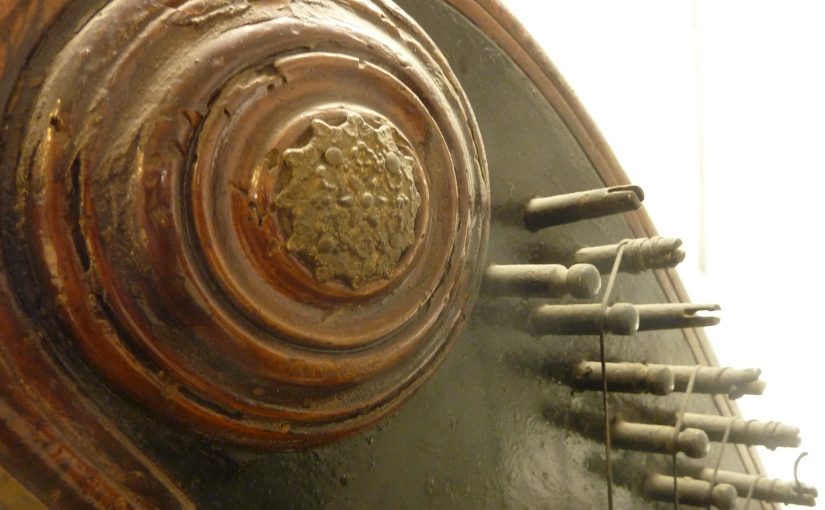
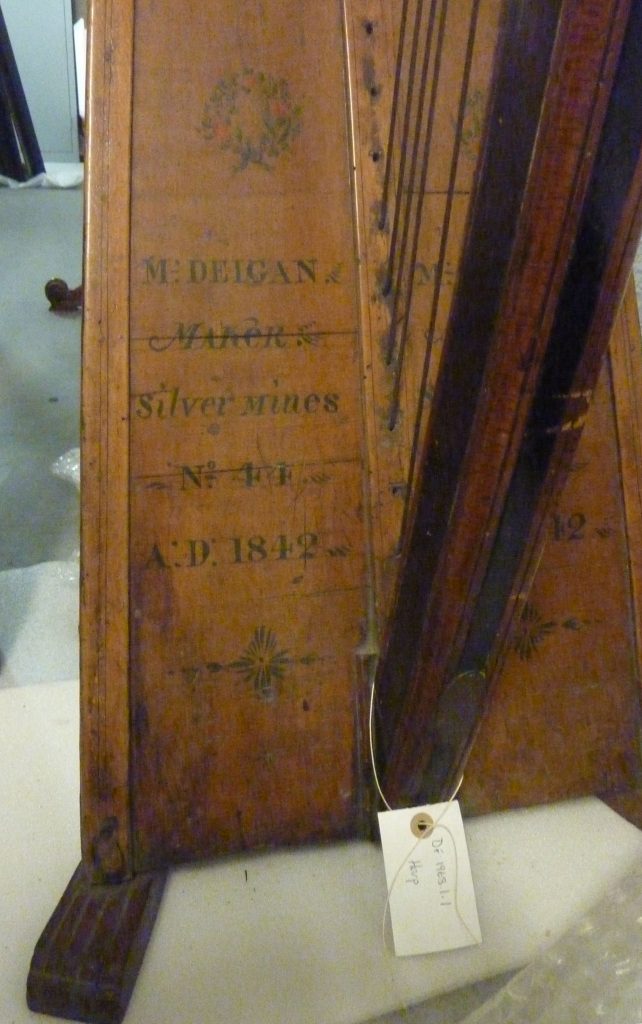
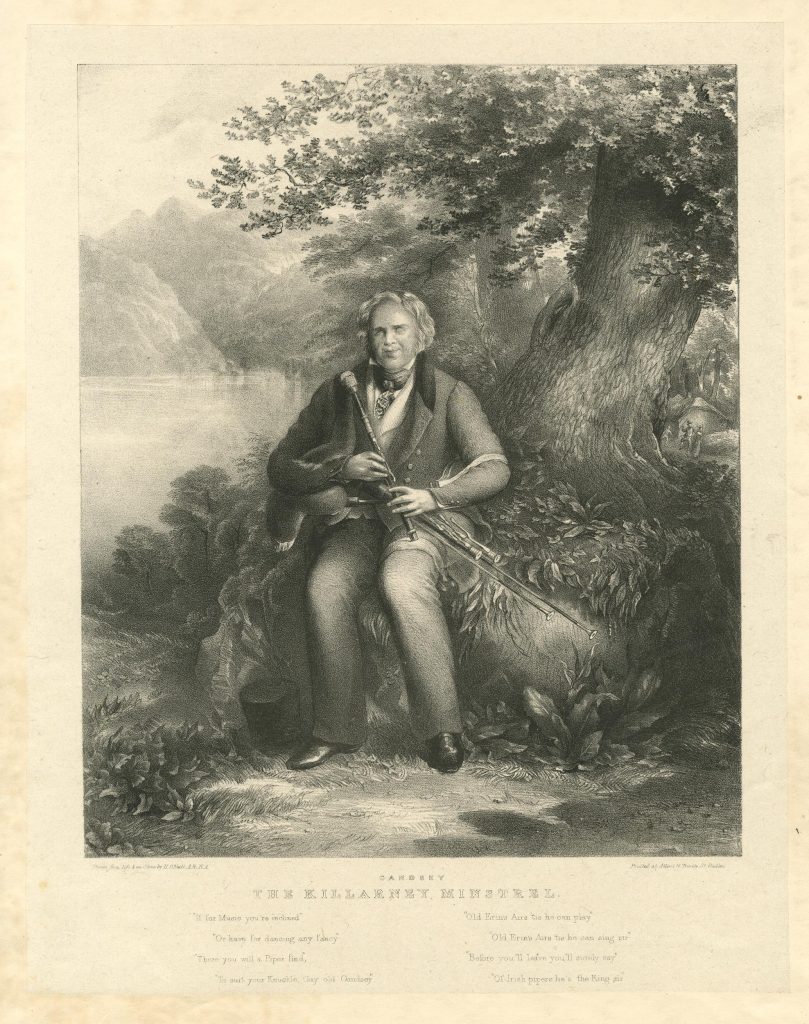
The NMI archivist sent me some information from the accession register, which states that the harp is 68 inches high, i.e. 173cm – so my guess of 1.8m is not bad.
The harp was purchased in 1968 from John Roche in Limerick, who said in a letter that it had long been in his family. At some point I may go to the Museum archive to read the entire file. But this is not a priority for me right now especially because I really suspect that this is a classical gut-strung harp and not a traditional wire-strung Irish harp.